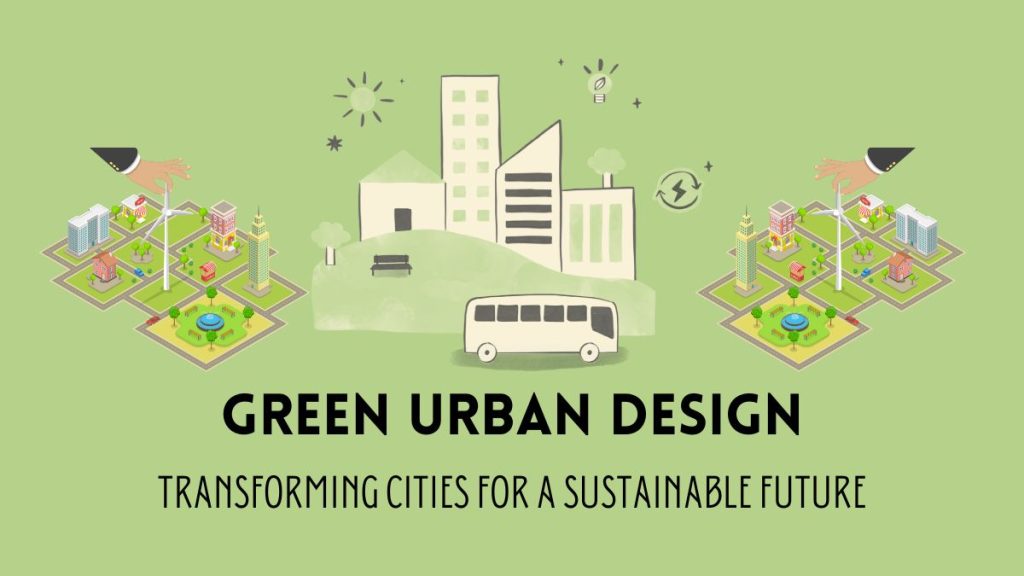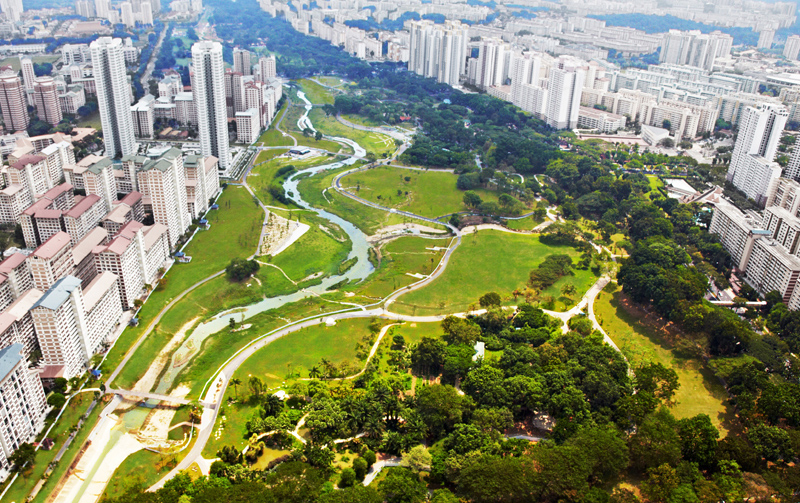Green Urban Design integrates nature into urban planning to create sustainable and livable cities. It promotes environmental health and enhances urban living.
Green Urban Design focuses on blending natural elements with urban spaces. This approach improves air quality and reduces urban heat islands. It also encourages biodiversity and supports mental well-being. Green roofs, vertical gardens, and parks are examples. These elements make cities more resilient to climate change.
Sustainable transportation options like bike lanes and pedestrian pathways are essential. This design philosophy fosters community engagement and social cohesion. Green Urban Design not only beautifies cities but also makes them more functional and sustainable. It is a vital step towards creating eco-friendly urban environments.
Related Article: Smart City Design: Transforming Urban Living for the Future

Related Article: Urban Design Principles: Transforming Cities for the Future
Introduction To Green Urban Design
Green Urban Design is a revolutionary approach to city planning. It integrates nature into urban landscapes. This design aims to create sustainable and livable cities. It focuses on reducing environmental impact. It also enhances the quality of life for residents.
Concept And Importance
Green Urban Design involves the use of eco-friendly practices. It prioritizes green spaces, renewable energy, and sustainable transportation. The design incorporates natural elements into the urban fabric. This helps to reduce pollution and improve air quality.
Key features of Green Urban Design include:
- Green roofs and walls
- Urban forests and parks
- Sustainable water management
- Energy-efficient buildings
- Public transportation systems
Benefits of Green Urban Design:
| Benefit | Description |
|---|---|
| Environmental Impact | Reduces carbon footprint and pollution. |
| Health Benefits | Improves air quality and physical well-being. |
| Economic Growth | Boosts local economies through green jobs. |
| Community Engagement | Encourages social interaction and cohesion. |
Historical Context
The concept of integrating nature into cities is not new. Ancient civilizations like the Romans had public baths and green spaces. In the 19th century, urban parks became popular in Europe and America. Cities like New York and London created large public parks.
In the late 20th century, the focus shifted to sustainability. Modern Green Urban Design emerged from this movement. The aim is to balance urban growth with environmental care. This approach addresses current global challenges like climate change.
Today, cities worldwide adopt Green Urban Design principles. They aim to create more resilient and adaptable urban environments.
Related Article: Urban Planning Trends: Transforming Cities for a Sustainable Future

Credit: www.asla.org
Related Article: Urban Design Ideas: Transform Your Cityscape with Innovation
Key Principles
Green urban design creates cities that are healthy and sustainable. Understanding the key principles helps us build better urban spaces. Below, we explore these principles in detail.
Sustainable Materials
Using sustainable materials is crucial for green urban design. These materials reduce environmental impact and promote health. Examples include:
- Recycled steel for construction.
- Bamboo for flooring and furniture.
- Reclaimed wood for various uses.
- Recycled concrete for roads and pavements.
These materials are not just eco-friendly but also durable and cost-effective. They help reduce waste and conserve natural resources.
Energy Efficiency
Energy efficiency is another key principle of green urban design. It aims to reduce energy consumption in buildings and infrastructure. Strategies include:
- Solar panels on rooftops.
- LED lighting for streets and buildings.
- Energy-efficient appliances in homes and offices.
- Insulation to maintain indoor temperature.
Energy-efficient buildings save money and reduce carbon footprints. They use less power and rely more on renewable energy sources.
By focusing on these key principles, we can create urban spaces that are both livable and sustainable.
Related Article: Design for Healing: Spaces that Nurture Well-being

Related Article: Green Building Techniques: Eco-Friendly Design for Modern Living
Innovative Practices
Green urban design is transforming cities into sustainable havens. Innovative practices are at the forefront of this movement. These practices enhance city life and combat environmental challenges. Let’s delve into some key innovations shaping urban landscapes.
Green Roofs And Walls
Green roofs and walls are revolutionizing urban architecture. They offer numerous environmental benefits and aesthetic appeal. These structures are covered with vegetation, providing a natural touch to urban settings.
Benefits of Green Roofs and Walls:
- Reduce urban heat island effect
- Improve air quality
- Enhance building insulation
- Reduce storm water runoff
- Promote biodiversity
Green roofs and walls contribute to energy savings. They help keep buildings cooler in summer and warmer in winter. This reduces the need for heating and cooling systems.
Urban Agriculture
Urban agriculture is an integral part of green urban design. It involves growing food within city limits. This practice provides fresh produce and reduces the carbon footprint of food transportation.
Forms of Urban Agriculture:
- Community gardens
- Rooftop farms
- Vertical farming
- Hydroponics and aquaponics
Urban agriculture fosters community engagement. People come together to grow and share food. This strengthens social bonds and creates a sense of belonging.
Advantages of Urban Agriculture:
- Access to fresh, local produce
- Education on sustainable practices
- Reduction in food deserts
- Improved mental well-being
- Economic opportunities through local markets
Urban agriculture also supports biodiversity. It provides habitats for pollinators and other beneficial organisms.
..jpg?1644514229)
Credit: www.archdaily.com
Related Article: How Does Architecture Help Society: Shaping Our World
Case Studies
Green Urban Design has transformed cities worldwide. Analyzing case studies helps us understand successful strategies and common pitfalls. Let’s explore some key examples.
Successful Cities
Many cities have embraced Green Urban Design with remarkable success. These cities have implemented innovative solutions to create sustainable urban environments.
| City | Key Initiative | Impact |
|---|---|---|
| Copenhagen | Bike-Friendly Infrastructure | Reduced Traffic, Improved Air Quality |
| Singapore | Vertical Gardens | Lower Temperatures, Better Air Quality |
| Portland | Green Roofs | Storm water Management, Energy Savings |
Lessons Learned
From these successful cities, we can extract valuable lessons.
- Community Involvement: Engage local residents in planning and decision-making.
- Multi-functional Spaces: Design areas that serve various purposes.
- Innovative Solutions: Utilize technology and green materials effectively.
These lessons can guide future urban design projects. They ensure environmental and social benefits. Cities can thrive by adopting these practices.
Future Prospects
Green Urban Design is the future of city planning. It focuses on creating sustainable and eco-friendly urban areas. This section explores the future prospects of Urban Design, shedding light on upcoming trends and innovations.
Technological Advances
Technology plays a crucial role in this urban design process. Smart grids help manage electricity efficiently. Solar panels and wind turbines are becoming more common. These technologies reduce reliance on fossil fuels. Green roofs and vertical gardens are also popular. They improve air quality and reduce heat. Electric vehicles and charging stations are essential. They help reduce pollution and carbon footprint.
Here are some technologies shaping the future:
- Smart Grids
- Solar Panels
- Wind Turbines
- Green Roofs
- Vertical Gardens
- Electric Vehicles
- Charging Stations
Policy And Regulation
Policies and regulations are important for Green Urban Design. Governments must enforce eco-friendly building codes. Tax incentives encourage businesses to go green. Carbon pricing helps reduce emissions. Urban planning should prioritize green spaces. Public transportation should be efficient and eco-friendly. Waste management systems need improvement. Policies should support renewable energy sources.
Key policies for future prospects:
- Eco-Friendly Building Codes
- Tax Incentives
- Carbon Pricing
- Green Spaces
- Efficient Public Transportation
- Improved Waste Management
- Support for Renewable Energy
| Technology | Benefit |
|---|---|
| Smart Grids | Efficient electricity management |
| Solar Panels | Reduce fossil fuel use |
| Green Roofs | Improve air quality |
| Electric Vehicles | Lower pollution |

Credit: landarch.illinois.edu
Conclusion
Green urban design promotes sustainable living and healthier communities. It reduces environmental impact while enhancing quality of life. Embracing eco-friendly practices in city planning is essential. Let’s prioritize green spaces and sustainable architecture for a better future. Together, we can create thriving, resilient urban environments.
Related Article: Mixed Use Development: Unlocking Urban Innovation and Growth

Pingback: How Does Architecture Help Society: Shaping Our World - SpaceArc